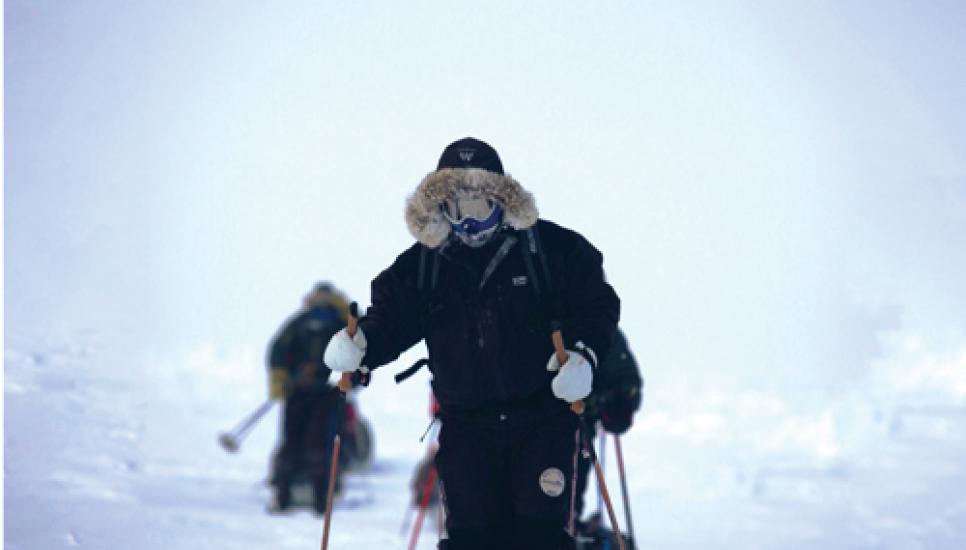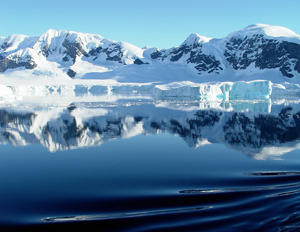Polar expeditions: walking on thin ice

The Arctic is apparently an agoraphobic’s and a claustrophobic’s nightmare. “At night, you’re so firmly strapped into your sleeping bag, you can’t even have your nose showing,” says Louise Hall, who fulfilled a lifelong dream of completing a polar expedition in 2010. Expose your nose for too long and you could become victim to frostnip or frostbite, she says, “It’s just your mouth”. “It’s also an agoraphobic’s nightmare because this sense of open space can, for some people, be really overbearing.”
The unforgiving and barren landscape of both poles has long captured explorers’ imaginations, most notably during the “heroic age of Antarctic exploration” around the turn of the 20th century. Even today, the public entertains romantic ideas about the likes of Sir Ernest Shackleton and his team, armed with reindeer sleeping bags and living off penguin and seal meat at the opposite end of the planet (and famously saving his entire 28-strong crew when their ship Endurance stranded during the Imperial Trans-Atlantic Expedition between 1914 and 1917).
But in the 21st century the polar regions have captured the public’s imagination in an entirely different and much more desperate way. Polar bears sitting atop shrinking ice floes have become a symbol of climate change, with the average temperature in the Arctic rising almost twice the average rate of the rest of the world, according to the Arctic Climate Impact Assessment – a project run by the Arctic Council and the International Arctic Science Committee. Already climate change is triggering an earlier Arctic snow-melt and sea ice break up, as well as altering ocean currents.
 Unlike the Antarctic (pictured, right), a frozen continent, the Arctic is frozen sea ice. Hall says the ice has “a life of its own, as it is constantly moving below you” and sleeping could be an anxious prospect as its movement could either work for or against you, floating towards or away from the pole. The physical highs and lows of the expedition were unlike any Hall had ever experienced. She explains: “When the sun is shining, the weather is good, the expansiveness of the polar scape is the most beautiful place in the world, with the glistening blue ice, the ethereal natural ice-sculptures, the brightness. But when the storms are coming in, it’s the most foreboding, cold, wind-whipping and wind-whipped place in the world.”
Unlike the Antarctic (pictured, right), a frozen continent, the Arctic is frozen sea ice. Hall says the ice has “a life of its own, as it is constantly moving below you” and sleeping could be an anxious prospect as its movement could either work for or against you, floating towards or away from the pole. The physical highs and lows of the expedition were unlike any Hall had ever experienced. She explains: “When the sun is shining, the weather is good, the expansiveness of the polar scape is the most beautiful place in the world, with the glistening blue ice, the ethereal natural ice-sculptures, the brightness. But when the storms are coming in, it’s the most foreboding, cold, wind-whipping and wind-whipped place in the world.”
She says the exhaustion is beyond any she’s ever known – “everything takes immense time and physical and mental effort because of the extreme cold”. A typical day, she explains, could be pulling her 60 kg pulk (a sled to carry supplies) for 18 hours including up and over ice rubble fields. “Despite wearing full face gear, one day I got raw frostnip on my left cheek,” she says, explaining her face was so numb she couldn’t feel there was 20mm of skin showing between her goggles and balaclava.
Their party was up at 5.30am or earlier every morning, ready for around 12 hours of walking, broken up by a five-minute break with a warm drink and energy snack every two hours. Hall explains the morning camp routine alone – dressing, lighting the stove, boiling snow for hot water, cooking breakfast and packing up camp – took at least two and a half hours. “Fire is your survival, so once you’ve got fire you can melt water, you can drink, you can start to refuel and you can warm up. It’s a way of getting heat back into your body, because it’s so cold that it’s a minus 60°C wind chill.”
According to Merlin Hanbury-Tenison, senior manager for private client services at merchant banking and operational risk business Salamanca Group, “From the desert, through to rainforest, tundra and mountains, the poles are certainly the expedition you need to be most prepared for out of all of them.” The company provides bespoke expedition packages as part of its services for ultra-high net worth clients. Hanbury-Tenison says these trips are increasing in popularity as clients try to find individually tailored breaks unlike anything that can be booked through a travel agent.
His colleague Philip Kaye, head of private client services, says the experience level of interested individuals ranges from absolute novice to skilled mountaineer. Kaye says their clients’ expeditions have ranged in length from four days to 93, and preparation for an expedition depends on the fitness and experience of the individual. “A lot of people train their whole lives to be able to go to the North or South Poles. The South Pole is obviously much harder, and they’ll train for a long period to be able to do it. To be able to get ready for it in a shorter period, say six months of intensive training, it needs to be something they can really commit to,” Kaye says.
The motivations to visit the Arctic or Antarctic include the personal challenge of reaching a pole, as well as an interest in wildlife or conservation. This can decide which end of the earth an individual might like to visit. “There’s less in terms of geological features, less in terms of interesting features, but then the wildlife is very interesting up in the Arctic,” Hanbury-Tenison says. In contrast, Antarctica’s large glaciers and numerous crevasses make the topography of the continent much more interesting, Hanbury-Tenison explains. “If their interest is purely on a challenge basis, then the South Pole is certainly a longer distance to get to the pole and there are more topographical challenges in between.”
Hall says her interest in polar exploration came at the age seven – something she has a very clear memory of – while studying Shackleton’s expedition at the Dragon School in Oxford, UK. “I literally remember sitting on the Lynam Hall floor cross-legged in my school uniform looking up at this black and white slide show of archive photos of men walking, pulling their pulks over the ice pans in this wild remote quasi-land and getting tingles, going ‘Where are the women?’ I thought ‘That’s extreme, that’s adventuring, that’s testing the limit, that’s living, just imagine ever experiencing that’.” She says her eventual driver was the awareness her generation may be the last to be able to walk to the pole. “It is a very real concept that my [five-year-old] son’s generation may be swimming to it.”
Hall’s 2010 expedition launched from Svalbard, Norway, with a team of six – including guides Inge Solheim and Henry Cookson. During the 240-kilometre trek, a recce for war veteran’s charity Walking with the Wounded, she found herself again drawing inspiration from Shackleton. “I had this book on Shackleton and every night I was going to bed and reading how he survived on pemmican (a mixture of fat and protein) and it made our experience feel mentally much easier because I was aware that we had the best kit and radio communication: if Shackleton could survive the cold wearing tweeds then we had nothing to complain about.”
Advancements in transport and navigational technologies, more comfortable clothing and durable equipment mean the Arctic and Antarctic are much more accessible now than in centuries gone by. Despite these technical gains, the weather and terrain remains unpredictable and reaching the poles has limited opportunity for success. Kaye says they therefore have to manage clients’ expectations. “If it looks like the weather’s going to close in, and you’re only a mile from the pole and that’s your last opportunity, you may have to turn around and walk back in the opposite direction. That can be quite galling for someone who’s trained for a year to get there.”
 Hall was lucky enough to make it to the North Pole, but their team was the first that year with six former teams failing due to poor weather. Unusually warm weather had opened up large open water leads – “essentially up to 30ft wide rivers in the ice” – that were hard to cross. “We sat out a two-day storm on the ice that, despite taking out one of our tents, meant the open ice leads froze over and the ice was thick enough for us to cross and eventually make it to the pole,” she explains. Unexpectedly when her team arrived back at Barneo, the North Pole base camp, the great broadcaster Sir David Attenborough (picured with Hall, left) and some of his film crew were there, capturing some of the last scenes for the seven-part documentary series Frozen Planet. “It was exceptional to see him and it was the ultimate surreal celebration to have a cup of tea with him on the top of the world!” Hall says.
Hall was lucky enough to make it to the North Pole, but their team was the first that year with six former teams failing due to poor weather. Unusually warm weather had opened up large open water leads – “essentially up to 30ft wide rivers in the ice” – that were hard to cross. “We sat out a two-day storm on the ice that, despite taking out one of our tents, meant the open ice leads froze over and the ice was thick enough for us to cross and eventually make it to the pole,” she explains. Unexpectedly when her team arrived back at Barneo, the North Pole base camp, the great broadcaster Sir David Attenborough (picured with Hall, left) and some of his film crew were there, capturing some of the last scenes for the seven-part documentary series Frozen Planet. “It was exceptional to see him and it was the ultimate surreal celebration to have a cup of tea with him on the top of the world!” Hall says.
The iconic wildlife narrator, who at the age of 84 became the oldest individual to visit the North Pole during that trip, was there to film the final episode in the series, which examined the threat of climate change on the Arctic and Antarctic regions. As Attenborough, speaking from the North Pole, told the nature series’ viewers: “Chances are that sometime within the next few decades there will be open water here for the first time in human recorded history.”
According to information released by Statistics Norway, an independent institution that operates under the country’s Ministry of Finance, short-term impacts of climate change could result in more tourists to the Arctic, with longer seasons, more bearable temperatures and increased accessibility as sea ice recedes. And visitors to the region aren’t necessarily a bad thing, according to Sven-Olof Lindblad, founder and president of Lindblad Expeditions, as they often become unofficial ambassadors for the region. “Exposing people to wild, beautiful, challenged places promotes understanding, creates interest where it might not have existed and, at times, action where needed.” But in the long term, the ice may recede to such a degree that a pole visit may not be possible.
Sticking to the high reaches of the Arctic, Hall’s expedition was about the personal challenge more so than the wildlife, and she now has a greater appreciation of how much the human body is made to withstand having returned. It was also a huge shift psychologically, she explains. “Coming back you don’t want for anything. We have so much and you realise how little you need to survive and it’s a really liberating, wonderful feeling.”
Polar bear expeditions While the personal challenge of reaching the North Pole is the motivating factor for many Arctic expeditions, polar bears are a huge attraction for travellers drawn to the region for zoological or conservational reasons. Merlin Hanbury-Tenison, senior manager for private client services at merchant banking and operational risk business Salamanca Group says the Arctic is an otherwise lonely environment and seeing a polar bear in its natural habitat is one of the “most thrilling experiences” a polar traveller can have.
While the personal challenge of reaching the North Pole is the motivating factor for many Arctic expeditions, polar bears are a huge attraction for travellers drawn to the region for zoological or conservational reasons. Merlin Hanbury-Tenison, senior manager for private client services at merchant banking and operational risk business Salamanca Group says the Arctic is an otherwise lonely environment and seeing a polar bear in its natural habitat is one of the “most thrilling experiences” a polar traveller can have.
But with sea ice receding year by year, Hanbury-Tenison explains the opportunity to see the bears in their natural habitat may not exist in as little as a decade. At the top of the food chain, the bears have an important role in the overall health of the marine habitat, and images of the white bear on shrinking ice floes have become a symbol of the effects of climate change. A threatened species since 2008, numbers currently stand between 20,000 and 25,000.
Melissa Scott, a guide with Natural Habitat Adventures, says a lot of visitors on her tours tell her they’ve come to see the bears “sooner rather than later” while they’ve still got the opportunity, saying climate change has brought the “charismatic” animal to the forefront of people’s minds.
Scott, who has been leading polar bear tours to Churchill, Canada, for more than a decade, says she has noticed changes to the region’s population (the animals are generally very loyal to one home territory over their lifetime). “We’re still seeing bears, but we’re seeing a change in how they’re distributed across the landscape.” Scott says, adding: “I definitely think polar bear tourism will be altered quite a lot over the next few decades.”
While the opportunity still exists, Hanbury-Tenison explains, an experienced guide can usually ensure polar bear sightings at any time of year, however, he cautions that because the bears can be aggressive, risk assessments and safety measures should be undertaken prior to an expedition.
Photography: Louise Hall, Henry Cookson Adventures, Press Association, Natural Habitat Adventures






